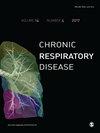肺动脉高压对高原慢性阻塞性肺疾病患者运动能力和气体交换的影响
IF 2.3
3区 医学
Q2 RESPIRATORY SYSTEM
引用次数: 1
摘要
背景:肺动脉高压(PH)与慢性阻塞性肺疾病(COPD)患者运动耐量下降有关,但在高海拔地区,这些患者对运动的反应尚不清楚。我们的目的是比较高海拔地区(2640 m) COPD患者(COPD-PH)和非COPD (COPD-非PH)居民的运动能力、气体交换和通气改变。方法:纳入132名COPD-非PH、82名COPD-PH和47名对照。在心肺运动试验中测量Borg量表、耗氧量(VO2)、工作速率(WR)、通气当量(VE/VCO2)、死腔与潮气量比(VD/VT)、肺泡-动脉氧张力梯度(AaPO2)和动脉-潮末二氧化碳压力梯度(Pa-ETCO2)。组间变量比较采用Kruskal-Wallis检验或单因素方差分析,逐步回归分析PH与运动能力的相关性。结果:所有COPD患者运动能力均低于对照组,PaCO2、a - apo2和VD/VT均高于对照组。预测VO2(61.3±20.6 vs 75.3±17.9);p < 0.001),预测WR %(65.3±17.9 vs 75.3±17.9;p < 0.001), COPD-PH组低于非COPD-PH组。运动高峰时,COPD-PH患者呼吸困难程度更高(p = 0.011)。运动时,COPD-PH组PaO2较低(p < 0.001), AaPO2 (p < 0.001)、Pa-ETCO2 (p = 0.033)、VE/VCO2 (p = 0.019)、VD/VT (p = 0.007)高于非COPD-PH组。在多变量分析中,PH与较低的峰值VO2和WR显著相关(p < 0.001)。结论:居住在高海拔地区的COPD患者,PH的存在是影响运动能力的独立因素。此外,COPD-PH患者在运动过程中呼吸困难和气体交换的改变比没有PH的患者更多。本文章由计算机程序翻译,如有差异,请以英文原文为准。
Effect of pulmonary hypertension on exercise capacity and gas exchange in patients with chronic obstructive pulmonary disease living at high altitude
Background: Pulmonary hypertension (PH) is associated with decreased exercise tolerance in chronic obstructive pulmonary disease (COPD) patients, but in the altitude the response to exercise in those patients is unknown. Our objective was to compare exercise capacity, gas exchange and ventilatory alterations between COPD patients with PH (COPD-PH) and without PH (COPD-nonPH) residents at high altitude (2640 m). Methods: One hundred thirty-two COPD-nonPH, 82 COPD-PH, and 47 controls were included. Dyspnea by Borg scale, oxygen consumption (VO2), work rate (WR), ventilatory equivalents (VE/VCO2), dead space to tidal volume ratio (VD/VT), alveolar-arterial oxygen tension gradient (AaPO2), and arterial-end-tidal carbon dioxide pressure gradient (Pa-ETCO2) were measurement during a cardiopulmonary exercise test. For comparison of variables between groups, Kruskal-Wallis or one-way ANOVA tests were used, and stepwise regression analysis to test the association between PH and exercise capacity. Results: All COPD patients had a lower exercise capacity and higher PaCO2, A-aPO2 and VD/VT than controls. The VO2 % predicted (61.3 ± 20.6 vs 75.3 ± 17.9; p < 0.001) and WR % predicted (65.3 ± 17.9 vs 75.3 ± 17.9; p < 0.001) were lower in COPD-PH than in COPD-nonPH. At peak exercise, dyspnea was higher in COPD-PH (p = 0.011). During exercise, in COPD-PH, the PaO2 was lower (p < 0.001), and AaPO2 (p < 0.001), Pa-ETCO2 (p = 0.033), VE/VCO2 (p = 0.019), and VD/VT (p = 0.007) were higher than in COPD-nonPH. In the multivariate analysis, PH was significantly associated with lower peak VO2 and WR (p < 0.001). Conclusion: In COPD patients residing at high altitude, the presence of PH was an independent factor related to the exercise capacity. Also, in COPD-PH patients there were more dyspnea and alterations in gas exchange during the exercise than in those without PH.
求助全文
通过发布文献求助,成功后即可免费获取论文全文。
去求助
来源期刊

Chronic Respiratory Disease
RESPIRATORY SYSTEM-
CiteScore
5.90
自引率
7.30%
发文量
47
审稿时长
11 weeks
期刊介绍:
Chronic Respiratory Disease is a peer-reviewed, open access, scholarly journal, created in response to the rising incidence of chronic respiratory diseases worldwide. It publishes high quality research papers and original articles that have immediate relevance to clinical practice and its multi-disciplinary perspective reflects the nature of modern treatment. The journal provides a high quality, multi-disciplinary focus for the publication of original papers, reviews and commentary in the broad area of chronic respiratory disease, particularly its treatment and management.
 求助内容:
求助内容: 应助结果提醒方式:
应助结果提醒方式:


